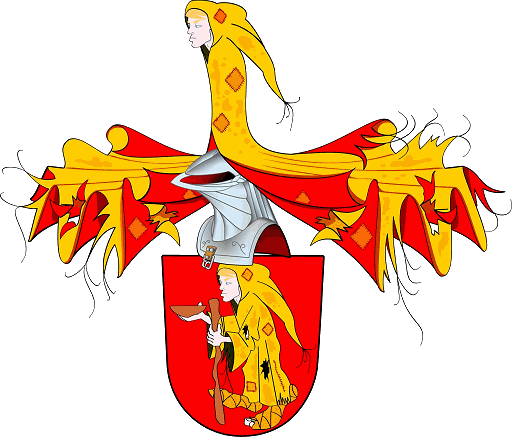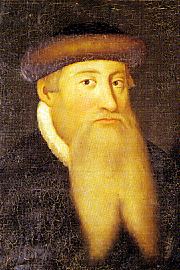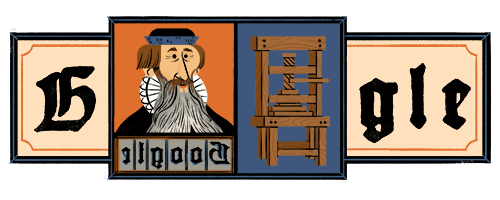

Johannes Gensfleisch zur Laden zum
Gutenberg (1400-1468)
Inventor of the modern printing process (1439)
The above is a copyrighted
picture
reproduced here by permission. © 2009 by
Jochen Wilke.
Gules, a beggar cloaked and
hooded, holding
a begging bowl dexter and a walking stick sinister, all Proper.
Like
Otto Hupp
and other modern heraldists,
Jochen Wilke feels that the beggar's garb is best rendered Or
instead of Proper.
This is consistent with the Germanic blending of crest and mantling used here
(the ragged mantling is a nice touch).
This composition is definitely one of Wilke's very best and it's
my personal favorite (so far).
It was highly praised by the noted heraldic artist
Daniel de Bruin.
(The Heraldic Ermine).


Johannes Gutenberg was a German goldsmith from
Mainz.
He adopted as a surname the name given to the
home of his parents,
possibly because his Gensfleisch family name did not sound
dignified enough (Gänsefleisch means "goose meat").
The Gensfleisch zur Laden family
seems related to the
Gensfleisch von Sorgenloch
whose arms also feature a beggar
(possibly a canting element for Sorgenloch
which evokes misery).
One of the main innovations of Johannes Gutenberg was the introduction
(c. 1439) of mass-produced
movable type,
using alloys of the metal formerly called stibium
(element 51, Sb)
which is now known as
antimony
(literally, "anti-monk")
precisely because Gutenberg's invention provided a printed alternative to the books
that were hand-copied by monks (Gutenberg Bibles, 1455).
Johannes Gutenberg also introduced the screw press and oil-based ink which made
modern printing possible.
By making the dissemination of information much easier,
Gutenberg's invention of an efficient printing process ushered in the
Renaissance.
It is has thus been construed as the most important innovation of the second millenium.

Wikipedia
|
Project Gutenberg










